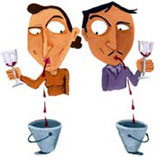– The Chicago Sun-Times reports on booming sales for Goose Island Brewing, up 60% this year. The reason is the deal the brewery struck less than a year ago with Widmer Brothers/Anheuser-Busch that put Goose Island beer in the hands of a large distribution force.
“We used to get a lot of calls — from Woodridge, Lake of the Hills — saying ‘I can’t find your beer,'” said brewmaster Greg Hall. “We don’t get as many of those calls anymore.”
– The St. Louis Post-Dispatch heads to Memphis on a beer selling trip with Dan Kopman of Saint Louis Brewery/Schlafly Beer (“We’re the other brewery in St. Louis”).
Schlafly is trying to carve out an identity by promoting its product as craft beer from America’s beer capital.
An interesting story about the challenges, including promoting beer in a market (Memphis) that so far has not been particularly craft friendly.

 Craft beer sales have been so strong of late that we headlined a story in this space a couple of months ago “
Craft beer sales have been so strong of late that we headlined a story in this space a couple of months ago “ It seems we failed to report this earlier, but having passed test marketing with flying colors Miller Chill is going national.
It seems we failed to report this earlier, but having passed test marketing with flying colors Miller Chill is going national.